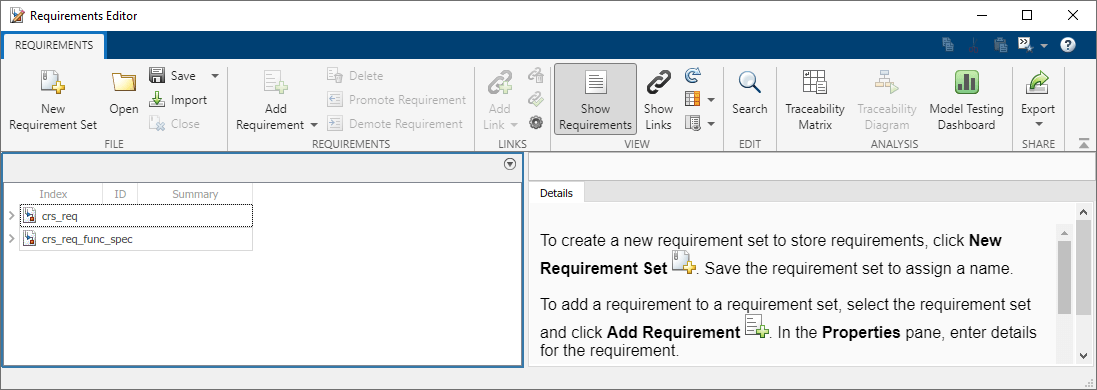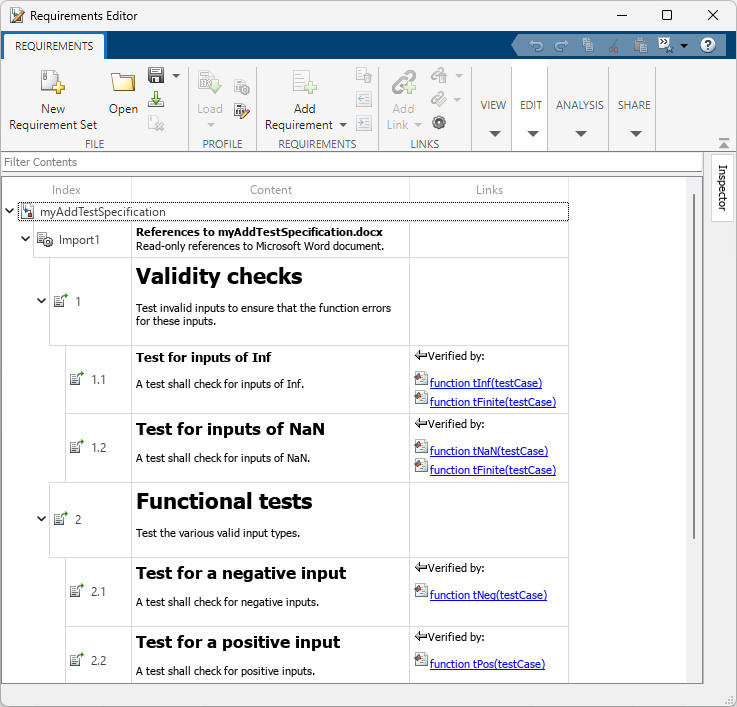需求编辑器
创建和编辑需求

打开 需求编辑器 App
Simulink® 工具条:在 App 选项卡的模型验证、确认和测试下,点击需求编辑器。
MATLAB® 工具条:在 App 选项卡的验证、确认和测试下,点击需求编辑器。
MATLAB 命令提示符:输入
slreq.editor。
示例
要创建新的需求集,请执行以下操作:
在需求编辑器中,点击新建需求集。
指定需求集的名称和文件位置。编辑器会将需求集保存为 SLREQX 文件,并且创建的需求集将显示在需求编辑器中。
您可以通过点击打开,然后选择需求集文件来打开现有的需求集。要删除需求集,请点击相应的需求集,然后点击“关闭”按钮 ![]() 。删除需求集不会删除对应的 SLREQX 文件。
。删除需求集不会删除对应的 SLREQX 文件。
要向需求集添加需求,请执行以下操作:
在左窗格中,选择一个需求集。
在需求部分中,点击添加需求。
在创建每个需求时都会随之创建一个相关联的 slreq.Requirement 对象。您可以在需求编辑器中或以编程方式编辑需求的属性。要在需求编辑器中调整属性,请点击相应的需求。该需求的属性将显示在编辑器的右窗格中。
要以文档形式查看需求,请依次点击显示需求 > 文档视图。您可以使用多行文档视图来查看需求详细信息,而无需使用需求编辑器的右窗格。

文档视图以两列的形式显示需求内容和链接。
提示
通过最小化右窗格来最大化需求编辑器中的查看空间。在右窗格中,点击“操作”按钮  并选择最小化。
并选择最小化。
要配置文档视图的内容,请执行以下操作:
在需求编辑器中,点击“列”按钮
 并选择选择属性。
并选择选择属性。使用“列选择器”对话框向文档视图中添加列。从隐藏列列表中选择项,然后点击添加。
从按以下顺序显示列名称列表中选择项并点击删除,从文档视图中删除列。
从按以下顺序显示列名称列表中选择项并点击上移或下移,以更改列的顺序。
点击确定以应用更改。
提示
为确保需求编辑器以预期格式显示需求描述的内容,请向文档视图中添加内容列,而不是描述列。
要将需求链接到模型中的工件,请执行以下操作:
在打开的 Simulink 模型中,点击一个模型元素。
在需求编辑器中,点击您要链接的需求。
在链接部分中,依次点击添加链接 > 从 Simulink 中所选内容链接。
有关详细信息,请参阅创建和存储链接。
要将需求链接到 MATLAB 代码行或纯文本代码(例如 C 或 H 文件),请执行以下操作:
在 MATLAB 编辑器中打开相应 MATLAB 代码或纯文本代码。
注意
您无法在 MLX 文件中创建指向 MATLAB 代码的链接。
选择您要链接的代码行。
提示
要链接到 MATLAB 函数并启用对整个函数体的更改跟踪,请创建指向包含
function关键字的行的链接。在需求编辑器中,选择您要链接的需求。
在链接部分中,依次点击添加链接 > 从 MATLAB 编辑器中所选内容链接。
有关详细信息,请参阅创建和存储链接。
要设置内置需求属性、自定义属性或构造型属性的值,请执行以下操作:
打开需求集。
在视图部分,点击显示需求。
选择一个需求。
在右窗格中设置属性的值:
内置属性 - 在属性下,将属性设置为指定的值。
自定义属性 - 在自定义属性下,将自定义属性设置为指定的值。
构造型属性 - 在构造型属性下,将构造型属性设置为指定的值。
要设置内置链接属性、自定义属性或构造型属性的值,请执行以下操作:
打开需求集。
在视图部分,点击显示链接。
选择一个链接。
在右窗格中设置属性的值:
内置属性 - 在属性下,将属性设置为指定的值。
自定义属性 - 在自定义属性下,将自定义属性设置为指定的值。
构造型属性 - 在构造型属性下,将构造型属性设置为指定的值。
默认情况下,需求编辑器会按字母顺序显示已加载的需求。要减少显示的需求数量,可以搜索显示的需求。
打开需求集。
在视图部分,点击显示需求。
在编辑部分,点击搜索。
执行搜索时:
如果某个需求集中没有任何需求通过过滤条件,则该需求集将不可见。如果有子需求通过过滤条件,则父需求集也可见。
过滤器不区分大小写。例如,输入 A 会显示列中包含大写或小写 A 的需求。
过滤器应用于编辑器中的列。如果您添加列,过滤器会自动应用于这些列。
默认情况下,需求编辑器会按字母顺序显示指向已加载需求集的链接。要减少显示的链接数量,可以搜索显示的链接。
打开需求集。
在视图部分,点击显示链接。
在编辑部分,点击搜索。
要在左窗格中显示额外的列,请执行以下操作:
决定您是要查看需求集还是链接集。要查看需求集,请在视图部分点击显示需求。要查看链接集,请在视图部分点击显示链接。
在视图部分,点击列按钮
 。
。
如果选择了显示需求,则可以从以下选项中进行选择:
实现状态:显示需求集的实现状态摘要。有关详细信息,请参阅使用实现状态跟踪需求链接。
验证状态:显示需求集的验证状态摘要。有关详细信息,请参阅审查需求验证状态。
选择属性:选择要显示的其他属性。您可以显示内置属性、自定义属性或构造型属性。
如果选择了显示链接,则只能点击选择属性。您可以显示内置属性、自定义属性或构造型属性。
显示属性后,您可以使用搜索功能对它们进行过滤。
要从第三方需求应用程序导入需求,请执行以下操作:
在文件部分,点击导入以打开“导入需求”窗口。
在文档类型属性中,选择文件格式。您可以选择 Microsoft® Word、Microsoft Excel®、ReqIF™ File 和 IBM® DOORS® Next。
在文档位置属性中,选择文件的位置。
设置导入选项。每种格式都有不同的导入选项。
如果您导入需求,Requirements Toolbox™ 会为每个需求创建一个 slreq.Requirement 对象。如果您将需求作为引用需求导入,Requirements Toolbox 会为每个需求创建一个 slreq.Reference 对象。有关详细信息,请参阅从第三方应用程序导入需求。
要为一个或多个需求集创建报告,请执行以下操作:
在共享部分,依次点击导出 > 生成报告。此时会打开“报告生成选项”窗口。
通过点击选择按钮来设置报告的文件名和位置。
选择报告内容选项。
选择要包含在报告中的需求集。包含的需求集部分显示已加载的需求集。要添加某个需求集,请使用需求编辑器打开该需求集。
点击生成报告。
有关详细信息,请参阅报告需求信息。
要访问“可追溯性矩阵”窗口,请执行以下操作:
在分析部分中,点击可追溯性矩阵。然后,您可以在该窗口中创建可追溯性矩阵。有关详细信息,请参阅使用可追溯性矩阵跟踪需求链接。
要创建可追溯性图,请执行以下操作:
点击一个需求集。
在分析部分中,点击可追溯性图。
有关详细信息,请参阅使用可追溯性图可视化链接。
如果您拥有 Simulink Check™ 的许可证,则还可以打开模型测试仪表板。要打开模型测试仪表板,请执行以下操作:
在分析部分中,点击模型测试仪表板。有关详细信息,请参阅Assess Requirements-Based Testing Quality by Using the Model Testing Dashboard (Simulink Check)和Explore Status and Quality of Testing Activities Using Model Testing Dashboard (Simulink Check)。
参数
视图
显示已加载的需求和需求集。要启用此参数,请在视图部分点击显示需求。您可以启用此参数或显示链接参数。
显示已加载的链接和链接集。要启用此参数,请在视图部分点击显示链接。您可以启用此参数或显示需求参数。
选择在查看已加载的需求集和链接集时要显示的属性和信息。在视图部分,点击列按钮 ![]() 。显示属性后,您可以使用搜索功能对它们进行过滤。
。显示属性后,您可以使用搜索功能对它们进行过滤。
选择您要在各个需求中显示的信息。要访问此参数,请在视图部分点击信息按钮 ![]() 。然后,您可以选择以下信息类型:
。然后,您可以选择以下信息类型:
更改信息:指示对需求所做的更改。有关详细信息,请参阅跟踪需求链接的变更。
注释:在所选需求的右窗格中添加注释部分。
代码可追溯性:显示需求的代码可追溯性信息。有关详细信息,请参阅将 MATLAB 代码链接到需求。
默认显示的信息类型是更改信息和注释。
提示
您可以使用需求管理器编辑和链接需求,而无需离开 Simulink 模型。导航到 App 选项卡的模型验证、确认和测试下,点击需求管理器,在 Simulink 模型中打开需求管理器。
当您在比较工具的 Base、Mine 或 Theirs 列中选择选项按钮时,点击需求编辑器中的刷新按钮可查看更新后的更改。
版本历史记录
在 R2017b 中推出依次选择显示需求 > 文档视图,会显示一个文档,其中显示每个需求的摘要、描述和链接信息。
MATLAB Command
You clicked a link that corresponds to this MATLAB command:
Run the command by entering it in the MATLAB Command Window. Web browsers do not support MATLAB commands.
选择网站
选择网站以获取翻译的可用内容,以及查看当地活动和优惠。根据您的位置,我们建议您选择:。
您也可以从以下列表中选择网站:
如何获得最佳网站性能
选择中国网站(中文或英文)以获得最佳网站性能。其他 MathWorks 国家/地区网站并未针对您所在位置的访问进行优化。
美洲
- América Latina (Español)
- Canada (English)
- United States (English)
欧洲
- Belgium (English)
- Denmark (English)
- Deutschland (Deutsch)
- España (Español)
- Finland (English)
- France (Français)
- Ireland (English)
- Italia (Italiano)
- Luxembourg (English)
- Netherlands (English)
- Norway (English)
- Österreich (Deutsch)
- Portugal (English)
- Sweden (English)
- Switzerland
- United Kingdom (English)